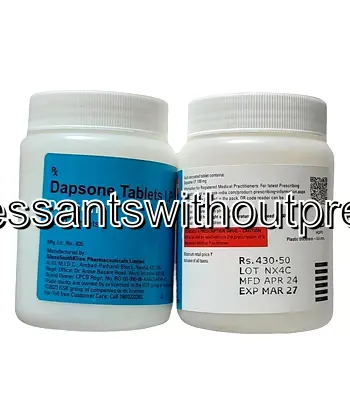| Package | Dosage | Price | Price per Dose | |
|---|---|---|---|---|
| Dosage: 1000caps | ||||
| 3 bottle | 1000caps | $923.49 | $307.84 | |
| 2 bottle | 1000caps | $677.86 | $338.94 | |
| 1 bottle | 1000caps | $371.62 | $371.62 | |

Dapsone Description
Understanding Dapsone: An Overview
Dapsone is a medication commonly used in the treatment of various skin conditions as well as certain bacterial infections. It belongs to the class of drugs known as antimicrobial agents, with anti-inflammatory properties. In the USA, dapsone is often prescribed for conditions like Hansen’s disease (leprosy), dermatitis herpetiformis, and specific types of pneumonia associated with HIV. Its effectiveness and versatility have made it a vital option in many dermatological and infectious disease treatments, especially when other medications are not suitable or have proven ineffective.
How Dapsone Works
The medication works by inhibiting the growth of bacteria and impacting the body's immune response. It targets specific bacteria responsible for the infections it's prescribed for, thereby helping to reduce symptoms and prevent disease progression. Additionally, dapsone exerts anti-inflammatory effects that can be beneficial in certain skin conditions characterized by immune overactivity. This dual action makes it especially valuable for managing complex dermatological cases, where controlling inflammation is crucial for patient comfort and healing.
Uses and Conditions Treated
Dapsone is most notably used for leprosy treatment, particularly multi-drug therapy along with other antibiotics. It is also prescribed for dermatitis herpetiformis, a chronic skin blistering condition linked to gluten sensitivity. In some cases, healthcare providers in the USA recommend dapsone for managing pneumonia caused by Pneumocystis jirovecii, especially in immunocompromised patients. Its use extends to certain manifestations of autoimmune disorders and specific types of skin rashes, always under careful medical supervision.
Potential Side Effects and Precautions
While dapsone is effective, it does carry the risk of side effects. Common adverse reactions include nausea, headache, and dizziness. More serious side effects may involve hemolytic anemia, methemoglobinemia, or allergic reactions. People with G6PD deficiency are at higher risk of hemolysis when taking dapsone, making screening essential before initiation of therapy. Regular blood tests are often necessary to monitor for blood cell counts and other potential complications, especially in long-term treatments.
Availability and Usage in the USA
In the United States, dapsone is available through prescription only, and pharmacists in online pharmacies follow strict regulations to ensure safe dispensing. When ordering online, patients should ensure they buy from licensed and reputable sources. The medication is typically dispensed in tablet form, with dosages tailored to individual needs. Patients are advised to follow their healthcare provider’s instructions carefully, including adhering to prescribed dosages and reporting any unusual symptoms promptly.
Patient Reviews and Experiences
Many patients in the USA who have used dapsone report positive outcomes, especially in managing persistent skin conditions and infections. Some appreciate its ability to control symptoms that other treatments could not. However, experiences with side effects vary, with some individuals experiencing mild discomfort and others facing more significant reactions. Patients generally emphasize the importance of regular medical monitoring and open communication with their healthcare providers to ensure safe and effective use of this medication. Overall, while not suitable for everyone, dapsone remains a trusted option for those requiring its specific therapeutic benefits.